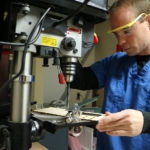Knee arthroscopy timing may complicate total knee arthroplasty
Knee arthroscopy, considered minimally invasive surgery, may lead to increased complications if performed within 9 months of a subsequent total knee arthroplasty (TKA), according to a study presented at the American Academy of Orthopaedic Surgeons (AAOS) 2021 Annual Meeting.

Why does my knee feel big, heavy, unnatural and weird after my total knee replacement? Implants used for knee replacements are on average 0.6 lbs heavier than a natural knee. Curovate. Photo Sabinevanerp. Pixabay
Jonathan Gelber MD, Medscape Medical News September 3, 2021
Using data collected from an insurance database, researchers from Washington University, George Washington University, and the Hospital for Special Surgery presented data on 8863 patients who underwent knee arthroscopy within 2 years of having undergone TKA
They found a statistically significant relationship between the timing of knee arthroscopy and complications following TKA. The odds of complications increased for knee arthroscopy 6–9 months (odds ratio [OR[:1.909; 95% CI: 1.636 – 2.214; P < .001), 3–6 months (OR: 2.286; 95% CI: 2.005 – 2.596; P < .001), and <3 months (OR: 3.430; 95% CI: 2.917 – 4.008; P < .001) before TKA.
Patients were also found to be at increased risk for periprosthetic joint infection (PJI) if the amount of time between knee arthroscopy and TKA was <9 months.
In an interview with Medscape Medical News, study author Peter Sculco MD, from the Hospital for Special Surgery, New York City, commented on the impetus for the study. “In our practice,” he said, “we had a few referrals of patients who were indicated for a total knee arthroplasty. On paper and on clinical exam, they looked like perfect candidates. However, the one glaring piece of their history was that they had received a recent knee arthroscopy.”
He noted that the knee arthroscopies were typically performed in hopes that they would reduce symptomatic pain, improve functionality, and delay the need for a TKA.
As literature emerged showing that the timing of corticosteroid injections was a risk factor for PJI following TKA, Sculco and his co-authors decided to see whether the timing of knee arthroscopy also played a role TKA outcomes, including PJI.
The authors found that in addition to an increased risk for PJI, there was an increased risk of needing manipulation under anesthesia (a surrogate marker for stiffness), regardless of recent knee arthroscopy timing.
“We were surprised by the finding that clinically significant knee stiffness occurred in all patients who we analyzed that underwent knee arthroscopy prior to TKA,” said lead author Safa C. Fassihi MD, of George Washington University, Washington, DC, in an interview with Medscape. “This suggests that even if there is a large gap between the two procedures, there’s still an elevated risk of stiffness that comes from the internal scarring produced by knee arthroscopy,” he said.
Sculco said that he hopes other surgeons will pay attention to the risk for infection and stiffness that comes with a TKA after recent knee arthroscopy. “We think that if you have a patient who had a prior knee arthroscopy, you should wait at least 9 months in order to minimize the risk of periprosthetic joint infection and revision. We also want other surgeons to know that these patients are going to be at increased risk of arthrofibrosis, so an aggressive physical therapy postoperative regimen may be warranted,” he said.
Sculco also believes their results suggest that caution is warranted before performing arthroscopic debridement for patients with largely degenerative arthritic knees. “We think that if the patients have reached the point where they may benefit from a total knee, then a knee arthroscopy provides minimal benefit,” he said.
Fassihi agrees with his co-author. “Hopefully, these findings also discourage surgeons from performing knee arthroscopy in patients with knee osteoarthritis, as not only does it not provide a significant benefit, but it may actually be detrimental to their ultimate outcome,” he said.
Fassihi recommends that patients who want to undergo TKA within 9 months of knee arthroscopy be counseled that they are at elevated risk for revision and PJI. Infections following TKA are major complications that can lead to years of morbidity. “Given the catastrophic nature of PJI, I would strongly suggest that they wait for the full interval of 9 months, even if living with debilitating pain,” he said.
Patrick Joyner MD, an orthopedic surgeon at Neuroscience and Spine Associates, in Naples, Florida, expressed an interest in the study but cautioned that database studies carry an inherent statistical risk. “I like the concept of the article,” he said in an interview with Medscape. “However, the problem with database articles is that, since there is such a large population, you don’t need much difference to get a statistically significant difference.”
But after seeing the data, Joyner said that he will definitely counsel his patients differently if they want to undergo TKA within 9 months of knee arthroscopy. “I know this will change my practice. I’ll do my best not to do arthroscopic procedures if I think they will not last longer than a year, regardless if the patient wants them or not. That being said, it does occasionally happen. So in that respect, I will tell the patient that they need to wait 9 months before total knee arthroplasty.”
In the future, Joyner would like to see more data on the patients who developed PJI. “I would like to know the comorbidities associated with the patients with a higher revision rate in the study, just out of curiosity, especially with the prosthetic joint infections. These large databases give you a picture of the forest but not of the trees. They don’t talk about patient comorbidities or any other numerous issues.”
Source Medscape Medical News
| References |
Comparison of Revision Risk Based on Timing of Knee Arthroscopy Prior to Total Knee Arthroplasty, Gu A, Fassihi SC, Wessel LE, Kahlenberg C, Ast MP, Sculco PK, Nunley RM. J Bone Joint Surg Am. 2021 Apr 21;103(8):660-667. doi: 10.2106/JBJS.20.00218.
Indications for Knee Arthroscopy in Patients with Osteoarthritis: Commentary on an article by Alex Gu MD, et al.: “Comparison of Revision Risk Based on Timing of Knee Arthroscopy Prior to Total Knee Arthroplasty.” Jones MH. J Bone Joint Surg Am. 2021 Apr 21;103(8):e33. doi: 10.2106/JBJS.21.00074. Full text
Conversion Total Knee Arthroplasty, Ramamurti, Pradip MD; Fassihi, Safa C. MD; Stake, Seth MD; Stadecker, Monica MD MBA; Whiting, Zachariah BA; Thakkar, Savyasachi C. MD. JBJS Reviews. September 2021 – Volume 9 – Issue 9 – e20.00198. doi: 10.2106/JBJS.RVW.20.00198
| Further reading |
Contemporary Prosthetic Joint Infection Management: Is There a Role for Suppressive Antibiotic Therapy? Sandiford NA, Kendoff DO. Arthroplast Today. 2021 Jul 31;10:133-134. doi: 10.1016/j.artd.2021.06.012. Full text
Prosthetic Joint Infections: an Update, Abad CL, Haleem A. Curr Infect Dis Rep. 2018 May 22;20(7):15. doi: 10.1007/s11908-018-0622-0. PMID: 29789958.
Prosthetic joint infection, Tande AJ, Patel R. Clin Microbiol Rev. 2014 Apr;27(2):302-45. doi: 10.1128/CMR.00111-13. Full text
Management and prevention of prosthetic joint infection, Shuman EK, Urquhart A, Malani PN. Infect Dis Clin North Am. 2012 Mar;26(1):29-39. doi: 10.1016/j.idc.2011.09.011.
Also see
Complications of Total Knee Arthroplasty Medscape
Why does my knee feel weird after my total knee replacement? Why does my knee feel heavy after my total knee replacement? Curovate






